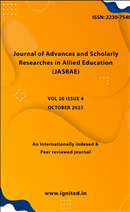Evolution and impact of Cybercrimes in India: Trends, Patterns, and Socio-Economic Implications
Keywords:
Cyber-crimes, Economic, Cyberspace, crime, prevention modelsAbstract
The patterns, trends, and effects of cybercrimes on the financial sector are the subject of this research. A thorough understanding of the nature and effects of financial cybercrimes is necessary since these crimes constitute serious dangers to people, companies, and governments. Cybersecurity experts, lawmakers, and law enforcement can better protect financial systems, organisations, and people from cyberattacks if they study the methods hackers use to compromise these systems. Significant monetary losses, diminished faith in online transactions, and interruptions to essential infrastructure and services are some of the far-reaching effects of financial cybercrimes on the economy. Beyond the obvious monetary losses, these effects ripple via investment choices, customer trust, and productivity. Financial cybercrimes may have a significant economic effect; stakeholders need to invest in cybersecurity, strengthen authentication mechanisms, and raise cybersecurity awareness to mitigate this. To further discourage cybercriminals and enable coordinated reactions to cybercrimes that span international borders, thorough rules and international collaboration are required. It takes a look at the many forms of cybercrime in India, the damage they do, and the steps the government and others have done to stop them. In addition to outlining possible solutions to lessen the impact of cybercrime, the paper emphasises the difficulties in doing so.
References
Khan, N.F., Ikram, N. & Saleem, S. (2023), Effects of socioeconomic and digital inequalities on cybersecurity in a developing country. Secur J . https://doi.org/10.1057/s41284-023-00375-4
Gourav Singh (2023), Cybercrime in India: Trend, challenges and mitigation strategies, International Journal of Law, Policy and Social Review, Volume 5, Issue 3, 2023, Page No. 95-99
Kshetri, Nir (2016). “Cybercrime and Cybersecurity in India: Causes, Consequences and Implications for the Future” Crime, Law and Social Change, 66 (3), 313–338.
Chen S, Hao M, Ding F, Jiang D, Dong J, Zhang S, Guo Q, Gao C. Exploring the global geography of cybercrime and its driving forces. Humanit Soc Sci Commun. 2023;10(1):71. doi: 10.1057/s41599-023-01560-x. Epub 2023 Feb 23. PMID: 36852135; PMCID: PMC9947441.
Ho, H.T.N., Luong, H.T. (2022), Research trends in cybercrime victimization during 2010–2020: a bibliometric analysis. SN Soc Sci 2, 4. https://doi.org/10.1007/s43545-021-00305-4
Kshetri, N. (2015). India’s cybersecurity landscape: the roles of the private sector and publicprivate partnership. IEEE Security and Privacy, 13(3), 16–23.
Bures, O. (2013). Public-private partnerships in the fight against terrorism? Crime Law and Social Change, 60(4), 429–455.
Salifu, A. (2018). Can corruption and economic crime be controlled in developing economies - and if so, is the cost worth it? Journal of Money Laundering Control, 11(3), 273–283.
Dilek S, Çakır H, Aydın M. Applications of Artificial Intelligence Techniques to Combating Cyber Crimes: A Review. Int J Artif Intell App. 2015; 6(1), 21–39.
Jaishankar K. The Future of Cyber Criminology: Challenges and Opportunities1. Int J Cyber Criminol. 2020;4(1/2):26.
Rid T, Buchanan B. Attributing cyber attacks. J Strateg Stud. 2015;38(1-2):4-37.
Broadhurst R. Developments in the global law enforcement of cybercrime. Policing: Int j police sci manag. 2016;29(3):408-33.
India emerging as major cyber crime centre (2019), Available at: http://wegathernews.com/ 203/indiaemerging-as-major-cyber-crime-centre/, Visited: 10/31/09
Hemraj saini,Yerra Shankar Rao,T.C.Panda ― Cyber crime and their Imapct A Review‖ IJERA March 2012 ,Vol 2 P.P No 201-206
Kshetri, N. (2013). Cybercrimes in the former Soviet Union and Central and Eastern Europe: current status and key drivers. Crime Law and Social Change, 60(1), 39–65.








